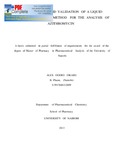| dc.description.abstract | Azithromycin is a semi-synthetic macrolide antibiotic that is active against a number of Gram positive and Gram-negative bacteria. Azithromycin is listed in the World Health Organization and the Ministry of Health, Kenya essential drugs list. Therefore, the quality of azithromycin products in the market is important because of its role in management of atypical infections. Liquid chromatography is the method of choice for the analysis of azithromycin in bulk samples and its formulations. However, the current published liquid chromatographic methods employ extreme conditions of pH and temperature and also expensive columns for the analysis of azithromycin.
In this study, a simple, isocratic, rapid, sensitive and robust reverse phase HPLC method was developed for the analysis of azithromycin in tablets, suspensions and raw materials. The effect of chromatographic factors including use of inorganic mobile phase buffer, pH, ion-pairing agent, organic modifier and temperature were investigated during development. Waters XTerra® CI8 column having the dimensions of 250x4.6 mm and 5 11mparticle size with mobile phase containinga mixture of acetonitrile-O.l M KH2P04 pH 6.5-0.1 M tetrabutylammonium hydroxide water (25: 15: 1:59 % v/v/v/v) was employed to achieve separation of azithromycin and its related substances. The pH of the buffer and ion pairing agent was brought to 6.5 using an equimolar solution of O.IM K2HP04. The mobile phase was delivered at a flow rate of 1 mllmin and the componentswere monitored at 215 nm while the column temperature was maintained at 43 "C. Theretention time of azithromycin was found to be about 8 min.
XVll
The proposed method was validated usmg ICH guidelines for the parameters of linearity, recovery, precision, sensitivity and robustness. The method was found to be linear in the range
50-150 percent with the coefficient of determination (r2) being 0.997. The LOD and LOQ were found to be 20 ug and 78 ug respectively. The method was found to exhibit good accuracy with the percent recovery of azithromycin being 100.7 %. The coefficient of variation for the repeatability and intermediate precision were within the limits prescribed by ICH.
The robustness ranges for the critical factors of pH, temperature and acetonitrile were investigated with the aid of Statgraphics Centurion XVI. The robustness range for pH was 6-7 pH units, 22-28% v/v for acetonitrile and 41-45 °C for temperature. At 95% confidence interval, p=0.05, acetonitrile had the biggest impact on the chromatographic parameters of the critical peak pair of azithromycin and erythromycin A imino ether.
The degradation of azithromycin in 0.0005% v/v H202 was found to be second order (r2=0.994) with a half life of 13 min. In O.lM H3P04 and 0.05M H3P04, 90% of azithromycin decayed within 10 min. In 0.025M H3P04, the degradation was found to be first order with r2 being
0.9907with a half life of 57.8 h.
The developed method was successfully applied in the analysis of azithromycin raw material and twenty two commercial products obtained from retail pharmacies within the Central Business District of the City of Nairobi. Thirteen of these products were tablets while nine were suspensions of azithromycin. Five of the nine suspensions sampled were premixed suspensions
while the rest were dry powders for reconstitution. Three tablet brands did not meet the United States Pharmacopoeia (2012) specifications for assay (90.0-110.0% label claim) while three of the premixed azithromycin suspensions did not meet the USP (2012) specifications. Similarly, one of the four dry powders for reconstitution suspensions failed to comply with the assay specifications.
The developed method is simple, robust, specific, accurate and stability indicating. It can therefore be used by quality control laboratories in the routine analysis of azithromycin bulk samples and formulations as well as in stability studies. The method can also be applied in post market surveillance to monitor the quality of products in circulation and detect counterfeits. | en_US |


